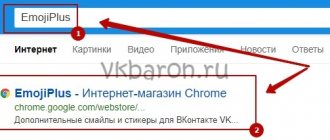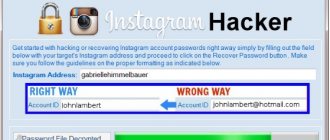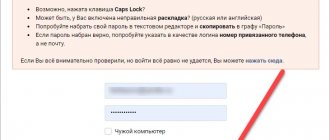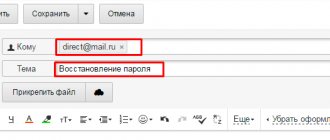How to see the password under asterisks (dots) in the browser
Some users, when registering on sites, do not remember the passwords saved in the browser, so when visiting the site again, the password is hidden with asterisks or dots for security purposes. This often happens: the browser offers to remember the password, the user agrees to this, but does not save the site password in another place, for example, by writing it down on a piece of paper.
At some point in time, the user needed a saved password to log into the site, for example, from another device: a laptop, tablet or smartphone. When entering the site, the “password” field is covered with dots or asterisks. How can I find out the password under the asterisks so I can copy it?
In some cases, synchronization (read more) used in browsers will help, provided that this function is used. But to log into your browser profile, you still need a password from your profile or account.
When using passwords, pay attention to the following points:
- The optimal solution for security purposes: use a special program - a password manager on your computer, for example, the free KeePass program. In this case, the user only needs to remember one password for the program; the remaining passwords will be saved in the password manager. If the browser does not remember passwords, then, if the browser is hacked, attackers will not be able to access the user’s personal data.
- For greater security, the password should be complex. To create a strong password, use the services of an online password generator.
Most users do not use password managers, so for some of them, there is a problem of forgotten passwords. Therefore, sometimes it is necessary to look through the stars or dots to copy the desired password.
In this article, we will look at ways to view hidden passwords in the browser. To display passwords in other programs, use third-party applications. For example, from this article, you will learn how to find out the Windows operating system key.
There are ways to see the password under the asterisks in the browser, without using third-party applications, directly in the browser itself, and using third-party programs. In this article, we will look at two methods that will help display the password under asterisks using browser tools, and one method when using a specialized program.
Viewing passwords using PasswordSpy
The operating principle of this utility is quite simple. Once launched, it scans all temporary browser files for saved passwords and produces a result indicating the name of the site or program to which it belongs.
True, the only drawback is that it only functions if temporary files were not cleared or deleted before it was launched. If the browser history, cache, cookies and temporary files have been deleted, you should not expect any results from the application.
Viewing the password under asterisks in the browser (method 1)
Now let's see how to see the password instead of dots using the console (developer tools) in the browser. In this example, I will use the Google Chrome browser. In other browsers, all actions occur in a similar way.
On one of the sites, when you enter the main page, fields for entering your login (I erased the login name) and password are displayed. Dots (or asterisks) appear in the password entry field.
We need to look at and copy the password hidden by the dots. Follow these steps:
- Right-click on the password field that displays asterisks or dots. In the context menu, select “View Code”, or press the keyboard shortcut “Ctrl” + “Shift” + “I”.
- In the console window that opens, in the “Elements” tab, the code for this site element will open, in which the line related to this element will be highlighted.
- We will need to change the following code element in the open line:
type=”password”
- Double-click on the “password” value with the left mouse button.
- Instead of "password", enter the word "text" (without quotes), and then press the "Enter" key. As a result, you will get a modified code element:
type=”text”
After this, the password will be displayed in the input field, hidden by dots or asterisks.
Close the console window, we won't need it anymore.
Now the open password can be copied for further use on another computer, laptop, smartphone or tablet.
After reloading the page in the browser, the password will again be hidden behind asterisks or dots.
In other browsers based on Chrome and Firefox, you can see hidden passwords in a similar way. Please note that the names of the context menu items that launch the developer tools (console) differ in different browsers.
To start viewing the element code in browsers, follow these steps:
- In Yandex Browser, after clicking on the password entry field, select the context menu item “Explore element” (Ctrl + Shift + I), then everything is done in the same way as in Chrome.
- In Mozilla Firefox, select the “Inspect Element” context menu item (Ctrl + Shift + I).
- In the Opera browser, select “View element code” (Ctrl + Shift + C) from the context menu.
- In the Internet Explorer browser, select “Check element” in the context menu.
- In the Microsoft Edge browser, you need to select the “Inspect element” context menu item, and then independently find the required piece of code. This is puzzling, since everything works correctly in Internet Explorer, as in other browsers. For some reason, this functionality is not fully developed in the new browser.
Using the Google Chrome browser
Let's say that you have forgotten the password for some service on the Internet and you need to recover or remember it. Let's remove all the stars then.
- Go to the Google Chrome browser and go to a specific site where there is a login form with the username and password already entered under asterisks.
- Now select all these points or simply place the cursor in the password field, then right-click and select “View Code”.
- On the right you will see a sidebar with the page code (especially for web developers). And you will immediately see the place in the code where the password is written. Pay attention to the field type="password". This piece of code means that all text you type in this field will be hidden from human eyes by asterisks.
- Double-click on this piece of code and you can edit it. But don't flatter yourself. Changes will not be saved. This thing will only show what will happen to this page if you change certain code in it. In general you need a word password change to word text. In this case, the password will not be displayed under dots or asterisks and you will be able to see it and write it down somewhere.
You can watch this process more clearly in this video.
Just? Of course it's simple. Well, now let's look at a couple of other browsers.
How to open a password under asterisks in a browser (method 2)
Another way to view saved passwords in your browser is in the settings of a specific browser.
In Google Chrome browser:
- Click on the “Customize and manage Google Chrome” button (the button is located in the upper right corner of the program window). Select "Settings", then click on "Advanced".
- In the “Passwords and Forms” section, in the “Password Settings” option, click on the arrow button. Sites with saved passwords are displayed here.
- Opposite the name of the desired site, click on the “Show password” button, and then copy the password.
In the Mozilla Firefox browser:
- Click on the “Open menu” button, select “Settings” in the context menu.
- Open the "Security and Privacy" tab.
- In the “Forms and Passwords” section, click on the “Saved logins...” button.
- Click on the “Display Passwords” button and copy the desired password.
In Yandex.Browser:
- Click on the “Yandex Browser Settings” button, select the “Settings” context menu item. Scroll down the page, click on the “Show advanced settings” button.
- In the “Passwords and Forms” section, in the “Offer to save passwords for sites” settings item, click on the “Manage Passwords” button.
- Find the desired site in the list of sites with saved passwords, click on the dots in the field to display the password. The “Show” button will be highlighted.
- Click on the “Show” button, after which the passwords under the dots will open. Copy the password for later use on another device.
In the Opera browser:
- Enter the “Menu”, click on the “Settings” context menu item.
- Select the "Security" section.
- In the “Passwords” setting, click on the “Show all passwords” button.
- Move the mouse cursor over the desired password and the “Show” button will appear. Click on the button, copy the password.
To display the saved password in Internet Explorer and Microsoft Edge browsers, for security purposes, you will need to enter the password for verification. Unfortunately, we don't remember him. Therefore, this method will not work for us in these browsers.
How to see the password under asterisks in the browser without programs
There are countless sites on the Internet that allow users to log in using data such as login and password; these can be forums, online stores and regular blogs. The data entry format is the same in most cases. So, how can I see the password in this form in the browser if it is hidden?
Using the element code
- Enter any password for the experiment in the field.
- Right-click on the field and select “View code”.
- A window opens with the HTML code of the entire page, but a certain block must already be selected.
- In the Input block we find the “type” attribute, where the value “password” is written.
- Double-click on the word and delete it or change it to the value “text”.
Click to enlarge image
Done, now instead of dots or asterisks the password will be visible in the form we wanted.
The example is considered in the Google Chrome browser. Same thing with other observers. For example, in Opera, right-click and select “View element code”. The Yandex browser and others have a similar principle.
In Microsoft Edge it's a little different:
- Open the login form of any site in Microsoft Edge.
- Press F12 to open Developer Tools.
- Click on the “Select element” icon (Ctrl+B) and point the cursor at the password form.
- Remove the password value from the type attribute.
Click on image to enlarge
Hidden password through browser settings
Any browser has a function for saving passwords, and you can view them there (Read: Password in the browser, how to find out?). In the latest version of Google Chrome this is done as follows:
- Click on the three dots at the top right.
- Select the “Settings” item.
- Go to the “Passwords” section.
- We see hidden saved passwords that need to be revealed.
- To view the hidden password, click on the eye icon.
- A window will open where you need to enter the password, PIN code or pattern that was configured when you turned on the computer. If a password is not set on the computer, the password will be displayed immediately. Read this if you forgot your Windows password.
Important! For security purposes, it is better to delete all saved passwords from the browser and store them in a more secure place, for example, the KeePass 2 program.
Script to view password under asterisks
There is a method that allows you to view all passwords available in forms. If the element code fails to reveal the password, this method will be used.
Here is the javascript code:
We go to the site where you need to enter a password. We write something in the field, and then paste this code into the address bar. Do not rush to press Enter, because at the very beginning of the code you need to write “javascript:”. When inserted for the first time, this part of the code is cut off.
Click to enlarge the picture
Now press Enter and see the password, which is in the corresponding field.
To avoid inserting the script every time, let's do the following:
- Right-click on the bookmarks bar and select “Add Page”.
- The name can be anything.
- Paste the code into the URL field.
- Click “Save”.
Now, every time you need to see the hidden password under the dots, click on this tab and the script will be activated.
We put on gloves and perform the operation...
So, we are slowly getting to the most important thing: how to see the password under the asterisks. From the examples described above, we realized that this can be done in two cases. Accordingly, we will consider them.
In browsers
- We will look at this example using the Google Chrome browser. The situation with other browsers will be described later. So, launch Chrome on your computer or laptop.
- Next, open the required site.
- Find the fields for entering login and password information on the page of the running site and right-click on your password under the asterisks.
- In the menu that appears, click on “View Code”.
- A special panel will open on the right, where a specific field will be highlighted in blue.
- Here we will need to change “type=password” to “type=text”. To do this, double-click on the word password with the left mouse button, type the word text instead and press the Enter key.
- Now in the password field you will see the combination that you used to log into a specific site.
Other browsers allow you to do this too. The steps are repeated, with the exception of the fourth point: in Opera you will need to select the “Inspect element” item, and in Mozilla Firefox you will need the “Inspect element” item. In other browsers, the instructions from Chrome are suitable, since they are built on the same engine. For example, you can easily do these manipulations in Yandex Browser.
However, in Opera, after right-clicking, we will have to select an item called “View element code”. This browser also allows you to use a special built-in extension. Thanks to the open source code, there is no need to worry about picking up viruses on your home or work PC. In Opera it is called Show my Password. After it is installed, click on its icon. We click on the button that offers to see hidden passwords and get the finished result.
Mozilla Firefox has a similar action scenario and an application with the same name as Opera. We install an add-on from the store for those cases when the user needs to see the passwords they are typing. When you enter and try to register in any resource, the Show and Hide buttons will appear next to you, which mean “Show” and “Hide”, respectively.
The Google Chrome browser has the ability to load the ShowPassword extension. It is absolutely safe, and therefore you can safely use it. But before you can work with it, you need to install it. After this, we go to any site that requires registration and identification. Just hover your mouse over the field called Password. The password will immediately become visible to the user. A one-time click on the corresponding field leads to the same result.
Installing third party applications
It turns out that you can find a lot of useful software on the Internet with the help of which we can display passwords, that is, make them visible. We recommend the free SterJo Browser Passwords utility for this purpose. We run it as an administrator. The program will display absolutely all passwords that have been saved by the given user in different browsers.
There are other applications, for example, Asterisk Password Spy and others. However, it is worth keeping in mind: not all of them are capable of running Windows 10, which is the most common operating system today.
Wi-Fi password
- Go to the “Control Panel” menu, which is located in “Start”.
- Now open the “Network and Internet” tab.
- Next, run “View network status and tasks.”
- In the window that appears, you will see a map of your connection to the World Wide Web. Active networks will include your wireless network (the text you need is highlighted in blue). Click on it.
- In the new dialog box, click on the “Wireless Network Properties” button.
- Now open the “Security” tab and check the box next to “Display entered characters”. This way, you will be able to see the password for the Wi-Fi wireless network instead of asterisks, even if the router does not have one.
How to see the password instead of dots using an extension
Google Chrome
There is a ShowPassword extension for this browser. It is open source, which means you won’t find any viruses or other unclean heresies there. Install the extension and try it in action.
After activation, enter data on any site and simply hover the mouse cursor over the Password field. The password will be displayed immediately.
ShowPassword offers 4 options to view your masked browser password:
- Mouse over – hover the mouse cursor;
- Double Click – double click;
- On Focus – one click on the field shows the password;
- Press Ctrl Key – press the mouse while holding the Ctrl key.
Mozilla Firefox
From the extension store, install Show/hide passwords. Now the user can easily find out the hidden password in the browser. A “Show” and “Hide” button will appear next to the field.









